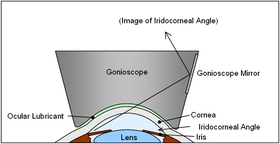Gonioscopy
| Gonioscopy | |
|---|---|
| Intervention | |

Goldmann Goniolens schematic
|
|
| MeSH | D006068 |
Gonioscopy describes the use of a goniolens (also known as a gonioscope) in conjunction with a slit lamp or operating microscope to gain a view of the iridocorneal angle, or the anatomical angle formed between the eye's cornea and iris. The importance of this process is in diagnosing and monitoring various eye conditions associated with glaucoma.
The goniolens allows the clinician - usually an ophthalmologist or optometrist - to view the irideocorneal angle through a mirror or prism, without which the angle is masked by total internal reflection from the ocular tissue.
The mechanism for this process varies with each type of goniolens. Three examples of goniolenses are the:
There are many other goniolenses available for use, including modified versions the aforementioned, which prove valuable for surgical use (goniotomy).
Although the details vary based on the type of goniolens used, in general the gonioscopy process involves:
The typical view through most goniolenses is illustrated by these idealistic schematic diagrams. In reality the clinical picture can vary both within and between individual patients. This view of the iridocorneal angle provides information in several ways:
...
Wikipedia
